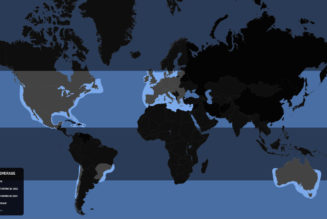Adorable drone footage came out last week showing two right whales touching bellies and wrapping their flippers around each other — appearing to “hug.” It was a moment rarely caught on camera. Scientists still aren’t exactly sure what that behavior really means, but the moment is a window into the dramatic world of whale sex and conservation.
[embedded content]
The video that’s been released to the public was just one snippet of a series of footage from two drones that was captured on February 28th in Cape Cod Bay, Massachusetts. The team documenting what happened that day included veterinarian and senior scientist Michael Moore from the Woods Hole Oceanographic Institution (WHOI), National Geographic photographer Brian Skerry, and Amy Knowlton from the New England Aquarium. The Verge spoke with Moore about what he saw that day, and why the video they captured is important.
This interview has been lightly edited for length and clarity.
What were you researching when your team caught this moment?
We’ve had a longtime interest in the health of North American right whales because they need to be healthy to be able to reproduce and make babies. The focus of so much of the conservation efforts for the endangered species or declining endangered species has been on reducing mortality. Mortality is really important stuff, obviously. But if you stop the mortalities, but you don’t enable them to have a better reproductive life, then the trend isn’t going to reverse. So you need babies.
As a veterinarian, I’m always interested in the condition of an animal. How does it look? For a wild animal, that means getting informative photographs because you can’t get hands on them. You can’t listen to them with a stethoscope. And so we’ve been working with colleagues since the late ‘90s to look at the body condition and the growth rate of North Atlantic right whales using aerial photography.
Can you walk me through the moments leading up to the event?
Essentially, our routine is to line up the stars in terms of weather, people, and whales. It was early in the season, so the information wasn’t that solid and the weather wasn’t that good, but we did have a good day. We hopped on the boat and out we went. We work with folks with the aquarium who are really good whale observers to help us find the whales, and Brian Skerry was also with us getting footage, stills, for his work in the magazine business.
We’d scoot around the bay looking for groups of whales, and we found some. Once we felt that we knew what was going on and settled down, we launched the drones.
The behavioral event that we documented there is called a surface active group; that’s where right whales come together and they spend time at and near the surface together.
What did you see the whales doing? Is what you captured considered a hug?
The word “belly-to-belly” is the word that has been used in the database of behaviors by the New England aquarium to standardize, “Okay, at this point in time, these animals are lying side by side and their bellies were touching each other.” So belly-to-belly is a neutral term that adequately describes what that video shows.
Were they hugging? I mean, we didn’t ever say they were hugging. But we asked the question because I think it’s a reasonable question. I guess hugging has an operational definition and an implication.
So, operationally, a hug is where two mammals — I don’t know, maybe only humans can hug, it all depends on how you define things — wrap their arms around each other. You know, the flippers of a right whale are homologous to the arms of a human. So physically, yeah, they were hugging.
If you include the concept of affection in the definition of a hug, then we don’t know whether they were hugging or not. We don’t know if they were showing affection or not. We can hypothesize that they were; it would be hard to test that hypothesis.
The hardcore scientists do believe that behaviors that humans demonstrate are unique to humans. Certainly it’s easier to interrogate two humans who have been hugging and ask them whether they were showing affection. You can’t do that for whales, so we really don’t know what they were doing.
One of the reasons why I wanted that video to be widely seen was there was an aesthetic in that video that certainly had some emotional qualities. And given the extent to which the right whale species has been devastated by anthropogenic trauma, a little bit of anthropomorphism, if that were to build some sympathy and empathy for these animals, is something that I’m totally prepared to indulge in. These animals need every piece of help they can get from the human race. They need a whole lot more love from many humans than they’re currently getting.
North Atlantic right whales are considered critically endangered, and “one step from extinction.” What threats are the whales facing from humans? [Editor’s note: the rest of the interview contains some graphic descriptions of both whale injuries and whale sex. Also, “sea serpents.”]
I’ve spent a fair amount of time looking at dead right whales on beaches to diagnose why they died, and the two primary causes of death we document are entanglements with fishing gear and collisions with ships. Collisions with ships generally break down into either being cut up like a loaf of bread with a spinning propeller, or they get hit by a blunt part of the ship, and then they get bruised and broken bones. That’s unfortunate and totally inappropriate, and needs to stop.
The entanglement process varies in terms of the size of the animal. The bigger and stronger they are, the more likely they are to successfully avoid drowning because they have enough power to swim up to the surface and break the gear away so they can breathe. If you’re entangled fatally, you’re probably going to take six months to die.
I don’t care if it’s a wild animal or if it’s a human, it shouldn’t happen.
:no_upscale()/cdn.vox-cdn.com/uploads/chorus_asset/file/22514394/639203958.jpg)
It must have been a welcome break for you to see healthy whales.
One of the motivations for us to share that video was that there’s been so much bad news about right whales. It was time to have something that was beautiful — and intriguing.
These surface active groups can involve copulation. We don’t know if any baby right whales were conceived that day. The two in that video were male so obviously not in that instance. But there were females around and there were active penises in the video and so on so forth.
So it’s as close as one comes to seeing some hope that these animals have a chance of recovering through sexual activity, which is good. Right whale reproduction is actually pretty extraordinary. I don’t know if you want to hear about it.
I do now. Were you able to actually capture reproduction from that group of whales that day?
I don’t know, to answer your question briefly. In the surface active groups, there are quite often observations of what we call “sea serpents.” And you can imagine what they really are: these long, flexible, snaky things. A right whale penis is about 12 feet long.
We did see penises waving around in the water. But we didn’t actually record any finishes in the right place.
Male right whales have the largest testicles of any living mammal. And that is because males have evolved to compete with each other, not physically or violently in any way, for access to the female, but purely by sheer volume. At times, we have had photographs in the past where not one but two finished in the right place at the same time. Because essentially, they try to flush each other out by having more volume than anybody else. I’m trying to be sensitive to this because it’s just a complicated topic. Chuckles
Did the two whales that were captured in that belly-to-belly moment have “active sea serpents”?
Actually what I recall was the active sea serpents were coming up from further down in the water column so they were from other whales.
Since your conservation research focuses on reproduction, is there anything that conservationists can do to encourage that behavior?
The behavior will happen when they’re ready to get pregnant, when they’re receptive. The receptiveness of these animals, I think, depends upon their health. If they are fit and fat and ready to commit to get pregnant, they’ll do it.
:no_upscale()/cdn.vox-cdn.com/uploads/chorus_asset/file/22514472/472571336.jpg)
So, what we have to do as conservationists is to enhance their health, not just stop killing them. How do we do that? We reduce these stressors that are reducing their health. Vessel collision and entanglement aren’t just mortality factors. They’re are also sub-lethal stressors. The sub-lethal stressors involved with vessels are sub-lethal collisions, and the noise that they make when they go by causing a reduction in the abilities of the animals to communicate with each other. Every entanglement is another detriment to their health. They may just brush against [fishing gear] and get a small scar and that really wasn’t a big deal. They may be entangled for weeks or months, and then they’ll get out of it. During that time, they’ve been towing gear and traps and rope around. It’s been traumatizing to their skin, to their blubber. The drag will increase their energy output, they need to feed more. They’ll probably lose weight.
So, what can we do to encourage that behavior? Get them into a situation where they are healthy enough to want to indulge in it.
Is there anything else you want people to know about right whales?
Anything they need to know about right whales they can read in my book that comes out in October, We are all Whalers.










